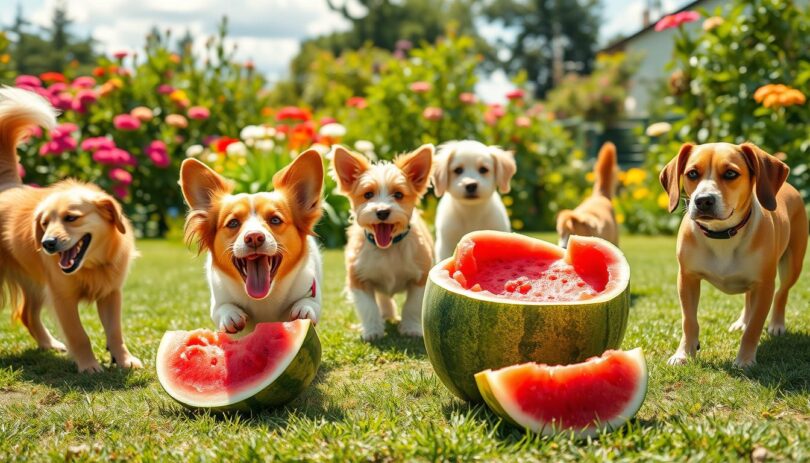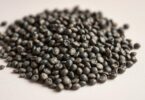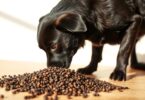92% of a watermelon’s weight comes from water, making it a hydrating summer snack. But what about the tough green exterior? While pets often enjoy fruit treats, the rind poses unique risks many owners overlook.
This article explores whether sharing watermelon with furry companions is safe. The juicy red flesh contains vitamins A, B6, and C—nutrients that support skin health and immunity. However, the fibrous rind lacks these benefits and may lead to stomach discomfort or blockages.
Veterinary experts emphasize moderation when introducing new foods. Even safe snacks should make up less than 10% of a pet’s daily calories. Proper preparation, like removing seeds and slicing flesh into bite-sized pieces, reduces choking hazards.
Owners seeking refreshing treats will find practical tips ahead. Sections cover nutritional advantages, serving methods like frozen cubes or purees, and warning signs of digestive distress. Always consult a veterinarian before altering a pet’s diet.
Understanding Watermelon for Dogs
Watermelon’s juicy flesh isn’t just a sweet summer snack—it’s a natural source of hydration and essential nutrients. When served properly, this fruit can complement a pet’s regular meals while offering refreshing variety.
Health Benefits and Hydration
With over 90% water content, watermelon helps regulate body temperature during outdoor activities. This makes it ideal for active pets or those prone to dehydration. The high moisture levels also support digestion by keeping the gastrointestinal tract moving smoothly.
Nutrient Overview: Vitamins and Minerals
Beyond hydration, watermelon delivers vitamins A, B6, and C. These nutrients strengthen immune function and promote healthy skin. Potassium aids muscle health, while fiber encourages balanced gut bacteria and regular bowel movements.
Fresh, seed-free pieces are safest for pets. Limit portions to a few small cubes weekly to avoid disrupting their primary diet. Always remove the rind and seeds first to maximize benefits and minimize risks.
Can Dogs Have Watermelon Rind: What You Need to Know
While watermelon flesh offers hydration benefits, its outer green layer presents hidden dangers many pet owners don’t anticipate. The firm texture and dense fibers create multiple health concerns despite being non-toxic.
Choking and Digestion Challenges
Chewing difficulty tops the list of hazards. The rind’s rigid structure resists breaking down during digestion, potentially causing stomach irritation. Small breeds face higher risks due to narrower throats and digestive tracts.
Veterinary reports show 18% of foreign body obstruction cases involve plant matter like fruit skins. Blockages often require endoscopic removal or surgery if not addressed quickly. Watch for vomiting, lethargy, or loss of appetite after accidental ingestion.
When to Seek Professional Help
Even small rind pieces can accumulate in the intestines over time. Immediate vet consultation becomes critical if your companion shows abdominal tenderness or struggles to defecate. X-rays help locate obstructions before complications escalate.
Prevention remains key—always discard trimmed rinds securely. Frozen flesh cubes provide safer cooling treats during warm months without the associated risks.
Preparing Watermelon Safely for Your Dog
Transforming this summer fruit into pet-friendly snacks requires careful preparation. Proper techniques preserve nutritional value while eliminating hazards. Follow these steps to create refreshing rewards your companion will love.
Properly Removing Rind and Seeds
Start by scrubbing the melon’s surface under running water. Use a sharp knife to slice off the green outer layer completely. Scoop out black seeds with a spoon—even seedless varieties may contain white immature seeds needing removal.
Chopping and Serving the Flesh
Cut the remaining pink fruit into thumb-sized cubes for medium breeds. Smaller pets need pea-sized portions. Freeze pieces in single layers on parchment paper before transferring to containers. This prevents freezer burn while maintaining texture.
Creative Treat Ideas: Frozen Cubes and Ice Cream
Mix pureed flesh with unsweetened yogurt for pups needing calcium boosts. Pour into silicone molds or lick mats for mental stimulation. For instant cooling relief, offer frozen chunks during play breaks. Always monitor consumption to prevent stomach upset.
These methods let pets enjoy watermelon’s hydrating benefits safely. Store prepared portions for up to three days in airtight containers. Rotate with other vet-approved fruits like blueberries for dietary variety.
Nutritional Benefits and Considerations
This juicy summer fruit serves as a smart addition to balanced pet meals when used thoughtfully. With only 46-50 calories per cup, it provides guilt-free variety without disrupting daily calorie limits. Unlike processed snacks, fresh pieces deliver natural hydration alongside essential vitamins.
Key nutrients like vitamin C boost immunity, while potassium supports heart health. The fiber content aids digestion when portions stay small—ideal for pets needing weight management solutions. Always prioritize high-quality dog food as the dietary foundation, using fruit treats as occasional supplements.
Compare typical meal components:
– Commercial kibble offers complete protein profiles
– Watermelon contributes extra moisture and micronutrients
– Combined, they create diversified nutrition without excess calories
Moderation remains critical. Overfeeding may dilute vital nutrients from primary food sources. Stick to 1-2 bite-sized pieces per 10 pounds of body weight weekly. Introduce gradually to monitor tolerance, adjusting based on individual needs.
This approach lets pets enjoy seasonal flavors while maintaining nutritional balance. Pair with other vet-approved fruits like blueberries for antioxidant variety, always keeping treats under 10% of total diet intake.
Signs of Digestive Issues and Vet Guidance
Pet owners should monitor their companions closely after introducing new foods. Common reactions like mild gas or brief thirst changes often resolve quickly. Persistent symptoms demand immediate attention—especially if they last over 24 hours.
Watch for these warning signs:
– Repeated vomiting or dry heaving
– Watery diarrhea or blood in stool
– Unusual tiredness or refusal to play
– Whining when touched near the abdomen
Contact your vet if any symptom appears. Delayed care allows blockages to worsen, risking emergency surgery. Share details about how much your pet consumed and when symptoms started—this helps professionals assess urgency.
Track bowel movements and energy levels for 48 hours after feeding treats. Keep fresh water available to prevent dehydration from gastrointestinal upset. Avoid giving dog larger portions until their system stabilizes.
Even properly prepared snacks can sometimes trigger sensitivities. Schedule a vet visit if mild issues persist beyond two days. Regular check-ups support long-term health by catching hidden problems early.
Always prioritize professional guidance over home remedies. Veterinarians offer tailored advice based on breed, age, and medical history. This proactive approach keeps pets safe while enjoying occasional fruity treats.
Final Thoughts on Watermelon Treats for Dogs
Summer offers endless opportunities to share refreshing snacks with furry friends. Watermelon’s juicy flesh provides essential hydration and vitamins when prepared thoughtfully. Always prioritize seed-free pieces and avoid the tough outer layer to ensure safety.
Creative serving methods make this fruit enjoyable for pets. Frozen cubes or blended purees offer cooling relief during outdoor adventures. Pair these with interactive toys for mental stimulation and portion control.
Moderation remains key—treats should complement balanced meals rather than replace them. Watch for signs of discomfort, especially after introducing new foods. Consulting a veterinarian helps tailor snack choices to individual dietary needs.
With proper preparation, watermelon becomes a seasonal favorite that supports wellness. Store pre-cut portions for quick access during park visits or backyard playtime. This approach keeps summer fun while prioritizing pet health.
By combining expert guidance with creative ideas, owners can confidently offer tasty rewards. Small steps like removing seeds and slicing carefully make big differences in safety. Happy tails and healthy habits start with informed treat choices.
FAQ
Is the green part of watermelon safe for pets?
The tough outer skin poses choking risks and may cause intestinal discomfort. Always remove it before sharing this fruit with your companion.
What should I do if my pet accidentally eats seeds?
While occasional seeds usually pass harmlessly, large quantities might lead to obstruction. Monitor for vomiting or lethargy, and contact your veterinarian if symptoms appear.
How does this fruit support a pet’s well-being?
The juicy flesh provides hydration during hot months and contains vitamins A and C, which promote healthy skin and immune function. Its low-calorie content makes it a smart snack choice.
What’s the safest way to serve this summer treat?
Cut seedless flesh into bite-sized pieces after washing thoroughly. For extra fun, freeze cubes in silicone molds or blend with plain yogurt for homemade pupsicles.










Leave a Comment